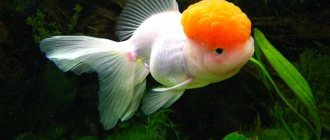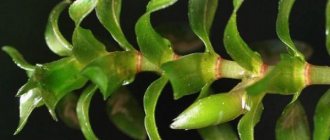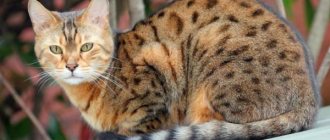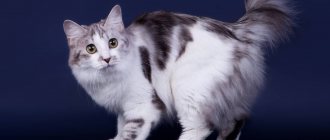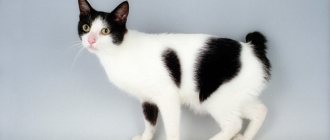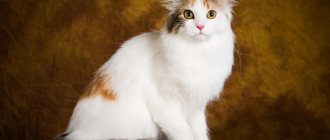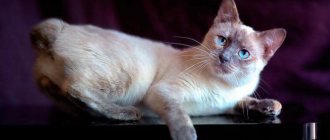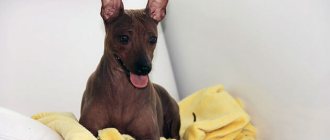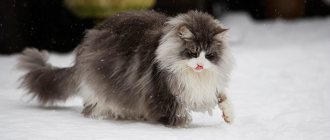The muscular, robust, medium-sized American Bobtail is similar in appearance to wild cats with a hunting gaze. Smart, good-natured, with highly developed intelligence, they have excellent health at the genetic level and are very attached to their owner.
Short- and long-haired, with a tail like a fluffy appendage, the bobtail breed has become the pride and national treasure of American cat lovers. It is very popular in the USA, but is rarely found outside.
- American Bobtail video
- Health and diseases
- How to choose a kitten
- Breed cost
- Nurseries
- Interesting facts about the breed
Hygiene and care of the American Bobtail
Cats of this breed are very unpretentious and do not require special care. Everything goes according to the standard rules:
- Timely treatment for fleas and helminths.
- Vaccination according to schedule.
- Spaying and neutering if you are not going to become a breeder.
- Brush the coat twice a week.
- Bath 1-2 times a year, unless the pet returns from a walk, rolling around in the mud.
- Examine your eyes periodically.
- Clean the ears from natural secretions.
- Have your teeth checked by a dentist and remove plaque in a timely manner to protect your gums from early periodontitis.
- Provide healthy and nutritious nutrition.
- Take him for walks regularly, giving him the opportunity to lie on the grass or climb trees.
Appearance and standards
The American Bobtail is a fairly large and beautifully built breed of cat with a shortened and movable tail. They have a stocky, moderately long body. Well developed physically with a hunter's look and a swinging gait. Above average intelligence. Sexual maturity is reached by three years.
Head and muzzle
The head is wedge-shaped with neatly rounded contours, without flats or noticeable bulges, and is proportional to the body. The ears are large with rounded tips, wide at the base. The eyes are almond-shaped, large, and located at a slight angle to the ear. The color of the iris has nothing to do with the coat and can be anything. The chin is full, its width and depth should coincide with the nose. The muzzle is slightly wider than it is long. In profile, a neatly concave curve between the forehead and nose is noticeable. The nose is wide and slightly curved.
Some breed enthusiasts believe that American Bobtails are related to the wild lynx found in southern North America, but their genetic connection has never been proven.
Frame
- the body is moderately long, maintains rectangular proportions;
- the chest is full and wide;
- the back is straight;
- wide hips;
- well developed muscles.
- paws are large and round.
The unique tail of the American Bobtail
The tail of the American Bobtail is short, flexible and expressive. The gene that is responsible for the mutation is dominant and uncontrolled; each kitten in the litter has tails of different lengths. Straight tails are preferred, but they can also be twisted or knotted.
According to the standard, the tail of adult cats must be at least 2.5 cm, but not lower than the hock joint.
Coat and colors
There are two variants of American Bobtails:
- Shorthair
cats have a springy short coat and a soft, moderately developed undercoat. - Semi-longhaired bobtails
are distinguished by dense, shaggy hair of medium length, with a soft undercoat (while the guard hair is much longer in the neck, chest, hind legs and on the croup).
The color of American Bobtails can be absolutely anything, from solid and striped to tri-color.
Proper nutrition or how to protect your pet from health problems
Cats, unlike dogs, are not able to chew everything and remain healthy. In particular, it is very harmful for bobtails to absorb carbohydrates, so human food and sweets are harmful to them.
The food should also be selected correctly, since it will be difficult for your pet to digest excess carbohydrates and problems with excess weight and diabetes will begin.
Natural nutrition
If the owner of an American Bobtail is a follower of natural nutrition, when creating a menu you should adhere to the following rules:
- The animal's meat diet may include beef, rabbit, chicken, turkey, chicken or beef liver, low-fat sea fish, and meat puree for children.
- Fish should not be given more than once a week to avoid unnecessary problems with urolithiasis.
- We serve the meat boiled, after removing the bones.
- Baby meat puree is great for kittens and animals during the postoperative period or during illness.
- From time to time, you can include low-fat cottage cheese and fermented baked milk in your diet. Milk in its pure form should be avoided as it causes intestinal upset.
- Be sure to give your animal a vitamin-mineral complex, which the veterinarian will prescribe, since natural food will not fully provide your pet’s body with everything it needs.
Health
These are strong, healthy cats. True, sometimes bobtails are born without a tail, and only a small hole in the place where it should be reminds of a tail.
In English, such cats are called “rumpie”. These kittens should be avoided as they may develop back problems.
Some bobtails suffer from hip dysplasia, or congenital dislocation.
This is a hereditary disease that, although not fatal, can be very painful, especially as the cat gets older. It leads to lameness, arthrosis and deprives the joint of mobility.
Specialized feed
The choice of food is an important criterion for a cat’s health. Here you should also follow some rules:
You can't skimp on your pet's health. Cheap dry food can cause digestive problems, cause urolithiasis, lead to vitamin deficiency, and problems with hair and skin. Preference should be given to premium food.
It is necessary to alternate dry and wet food. For example, give dry food during the day, and offer soft food for dinner.
IMPORTANT: dry and wet food must be from the same manufacturer.
There should always be clean and fresh water in the bowl.
How much can an American Bobtail kitten cost?
Cats of this breed were bred in the USA and, despite the great love of the world community for bobtails, there are very few nurseries outside of America, and it is not easy to buy a kitten.
The only option to purchase such beauties in Russia is to find a private breeder or visit an international cat show.
How much do American Bobtails cost in the States? Differently. The final cost depends on the pedigree, the presence of a veterinary passport, and the necessary vaccinations.
The price of an American bobtail in Russia ranges from 30 to 60 thousand rubles. The evaluation criteria are the same: pedigree, passport, vaccinations, compensation for keeping in the nursery.
True friendship is priceless. An easygoing disposition, sweet appearance, and sincere love are worth purchasing a four-legged friend from the American Bobtail breed.
Description of the breed
The table provides a description with information about the appearance standards of the American Bobtail breed.
Table No. 1
| American Bobtail: USA - Country of Origin | |
| External data | Description of the breed, according to the TICA standard |
| Body. | Medium in size, muscular. The entire physique is distinguished by a rectangular athletic shape, and the wide chest is decorated with patterns in the form of closed rings. powerful thighs. The nose is outlined in the main color of the design. |
| Paws, limbs. | The legs are proportional to the body, strong, of medium length, ending in large paws with woolen bracelets. A feature of their long-haired species is that they have tufts of hair on their paw pads between their toes. |
| Tail. | A short tail is a distinctive feature of the breed. It can reach from 3 to 8 cm. It can be flexible, straight or slightly curled at the end. |
| Head, muzzle. | It looks like a wedge in shape and size with a volume proportional to the body. The muzzle is rounded, slightly wide with convex cheeks in graceful curls. Volumetric pads with long whiskers. The jaws are strong, the chin is wide, powerful, and well developed. With their muzzle they look like a wild animal, a lynx. |
| Eyes, eye color. | A breed with large almond-shaped eyes extended towards the ears. Eye color can be different, it may match the color or even differ. |
| Ears. | Small ears, widely spaced on the head. Wedge-shaped with widening towards the bottom. The tips are rounded at the ends with fluffy tassels. |
| Nose | Wide with a bend at the bridge of the nose and a small hump. |
| Weight: | |
| cats | On average 3-5 kg. Females are inferior in size and weight to males. |
| cats | On average 7-9 kg. |
| Lifespan | On average, 13 – 15 years old. Kittens grow for a long time and mature by 3 years. |
Interesting! Looking at photos of American Bobtail cats, you can clearly see their original features, a short tail, and most importantly, how similar they are in appearance to a wild lynx.
Shorthair
One type of breed, the American Bobtail Shorthair, is ideal for keeping at home. The body is of medium length, with erect hairs, elastic hair and a short dense undercoat that requires almost no grooming.
Longhair
The American Bobtail is long-haired and has medium-length tousled coat. To the touch, cats and cats are soft and smooth with a fluffy covering, the neck is wrapped in a lush collar. Pants with longer hair form on the hips and limbs, and tufts of hair appear on the pads of the paws between the toes.
Important! Both shorthaired and longhaired bobtails are officially recognized breeds by TICA and the American Feline Association.
Colors
American Bobtail cats have the popular “wild” cat color pattern. Among the Yankee bobbies there are striped, spotted, marbled, and ticked. They come in a variety of coat colors ranging from black and red to chocolate brown and cinnamon. Less common are blue, lilac, cream and white colors.
- smoky “wild” with fur that resembles a lynx in pattern;
- spotted with rosette-like spots;
- brown tabby with a characteristic pattern on a red-brown background;
- black with a pattern on a gray-blue background;
- chocolate tabby with stripes on a light bronze coat;
- red with a pattern on peach color;
- cream with a spotted pattern on a cream background;
Important! American Bobtail cats have a distinctive scarab mark on their forehead, like the letter “M”. Eyes and nose with rim.
The natural tabby, “wild” color, allowed the ancestors of the American bobtail to survive in the harsh conditions of reservations; the modern breed does not show any aggression, except for the hereditary passion for hunting rodents.
